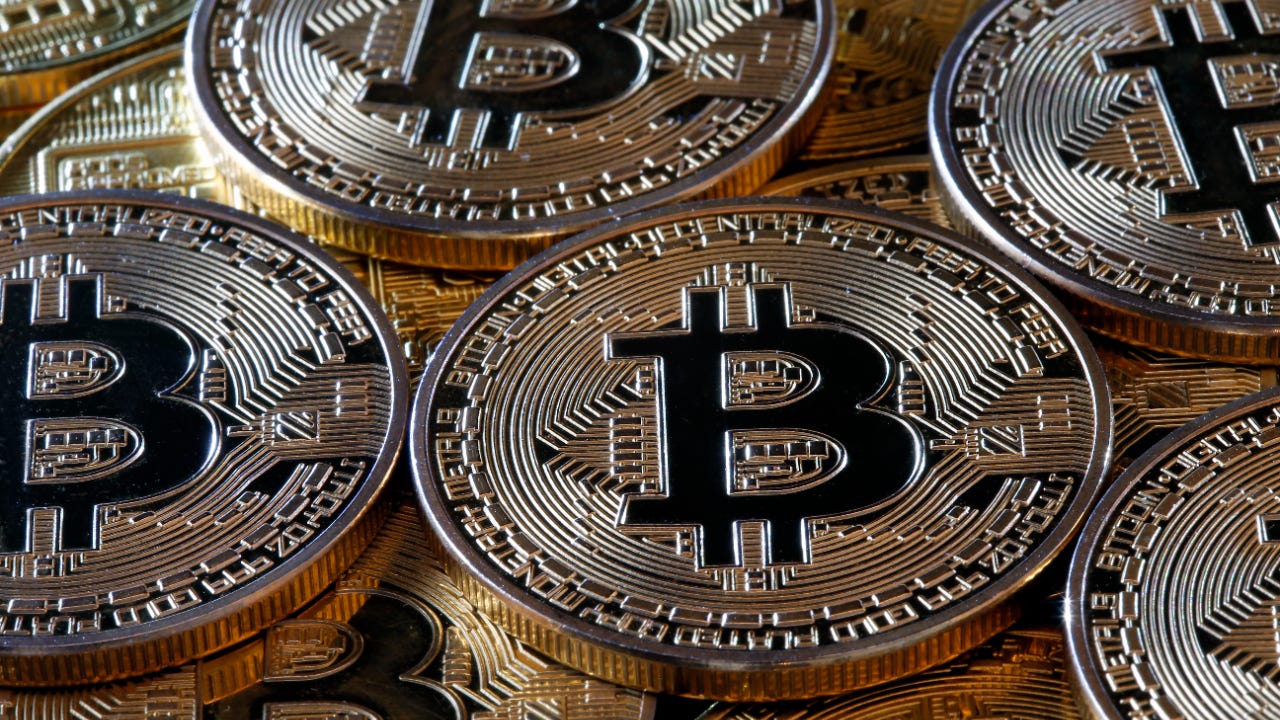Bitcoin price history: 2009 to 2024

The Bankrate promise
At Bankrate we strive to help you make smarter financial decisions. While we adhere to strict , this post may contain references to products from our partners. Here's an explanation for .
Bitcoin’s price has been on a roller coaster ride since it first debuted in January 2009, but the long-term trajectory has been higher – “up and to the right,” as they say. Bitcoin ushered in the age of cryptocurrency, but it took quite a while before the public sat up and took notice.
Still, in little more than a decade, cryptocurrency, and in particular, Bitcoin, has become one of the most exciting trading opportunities in a long time. Bitcoin trading has created millionaires, though given that persistent rise since its debut, plenty of traders would have done fine just holding – or HODLing – on for the ride, as many long-term bullish owners have done.
Despite the long-term rise, Bitcoin has been dogged by periods where it’s fallen precipitously. The most recent has been from November 2021 through 2022, when the prospect of rising interest rates and reduced liquidity in the financial markets sent Bitcoin’s price much lower.
Bitcoin was unleashed in the months after the global financial crisis obliterated economies. It was created by a mysterious individual or group known as Satoshi Nakamoto, and early proponents touted the currency’s promise of moving monetary policy out of the hands of governments and central banks and into an autonomously managed system.
Bitcoin famously has a maximum of 21 million coins that can ever be created. In the face of this fixed supply, an ever-increasing demand can send the cryptocurrency soaring. Given these dynamics, speculators have rushed into the space to take advantage of the anticipated price appreciation.
The price of Bitcoin is notoriously driven by sentiment. When the market shifts to its “greed” phase, Bitcoin soars amid the utopian promises and speculators dismiss the risks of an asset that generates no cash flow. In the “fear” phase, Bitcoin’s price seems to find no traction, as sellers push its price lower amid bad news or general market malaise.
Amid all of this speculation, however, it’s important to remember that Bitcoin is tough to use for everyday purchases. Major companies that introduced ways to pay with Bitcoin have quietly walked back those initiatives. Now the market has rewritten the narrative from Bitcoin as a medium of exchange to one where it’s a store of value, “digital gold.” However, gold has a few thousand years of history as a store of value, compared to little more than a dozen for Bitcoin.
Here’s how the price of Bitcoin has risen and fallen over time as well as some of the trends driving those moves.
January 2009 – July 2013: Bitcoin is created and attracts techies
The New Liberty Standard Exchange recorded the first exchange of Bitcoin for dollars in late 2009. Users on the BitcoinTalk forum traded 5,050 bitcoins for $5.02 via PayPal, making the first price mediated through an exchange a bargain basement price of $0.00099 per bitcoin. In other words, the price was about one-tenth of one cent.
While Bitcoin was officially launched on January 3, 2009, it’s tough to find any standard pricing before mid-2010. That’s because there weren’t exchanges in the same way that there are today. However, data became available in July 2010 and continues to this day.
It was in 2010 that the most expensive pizzas of all time were purchased. One Bitcoin owner offered 10,000 bitcoins for two pizzas, an offer that continues to live on in Bitcoin lore. It’s considered the first time that anyone used virtual currency to buy something in the real world.
According to historical data at Investing.com, Bitcoin’s price never broke above $0.40 per bitcoin in 2010 but did manage to hit that level in early 2011. Then in February, it crossed $1. Just a few months later, in May, it briefly exceeded $8 – a stunning 8-bagger in mere months!
By June 2011, Bitcoin’s price had hit nearly $30, a seemingly unimaginable rise from just months before. And that’s where it topped out for the year. Bitcoin spent the remainder of 2011 just dwindling to as low as $2, before finishing the year at $4.70. After this bubble burst and a more than 90 percent fall from its all-time high, it might have seemed as if the Bitcoin fad was over.
In 2012, Bitcoin spent much of the year consolidating, slowly growing stronger throughout the year. In November 2012, Bitcoin went through its first “halving,” a change in the reward structure for miners, where they receive half as many bitcoins for mining blocks on the blockchain. As 2012 came to an end, Bitcoin finished at $13.50, just off the highs for the year.
That consolidation set up Bitcoin for a strong run in 2013 when it began to attract more notice outside a niche audience of techies and hobbyists. The world’s first Bitcoin ATM was installed in Vancouver, allowing buyers to change fiat money for crypto. By the end of January, Bitcoin’s price had already risen to more than $20. The momentum built from there, as interest spread.
By early March, Bitcoin had already doubled again, rising to more than $40. A couple of weeks later it surpassed $50, and then days later $60. It climbed to $70 the day after that. By the start of April 2013, Bitcoin had passed $100 in breathtaking fashion. Then eight days later it spiked to $230!
From there, it was just a week until Bitcoin was back at $68, as the bottom fell out. But then a week later, it had doubled again and traded north of $150. After the strong trading action in April and May, Bitcoin spent June and July settling down. Surely this was the peak of insanity for Bitcoin volatility.
August 2013 – December 2017: Bitcoin breaks through to popular consciousness
After months of consolidating from its rise earlier in the year, Bitcoin reached new heights in November 2013. Priced at $213 entering the month, Bitcoin doubled to nearly $435 just 12 days later. By the end of the month, it had nearly tripled from there, up to more than $1,200, before ending the year at $805, a real downdraft, but still up from just $541 a couple of weeks before. Late in the year, the People’s Bank of China banned financial institutions from using bitcoins.
The year 2014 saw Bitcoin retain its signature volatility. After hitting $1,000 in early January, Bitcoin bottomed at $111.60 on Feb. 21 – a decline approaching 90 percent! Behind the turbulence were problems at Mt. Gox, one of the earliest crypto exchanges. The exchange had stopped withdrawals, then filed for bankruptcy after losing 744,400 bitcoins of users’ funds.
Then a mere five days later, Bitcoin recorded a price of $593.10 – more than a 5-bagger in days! Bitcoin spent the rest of the year gradually declining and closed 2014 at about $318.
The year 2015 started with Bitcoin declining, but most of the year was a slow uptrend, unusual for Bitcoin, and it ended the year at $430. In November, the official Bitcoin B symbol was adopted.
The first half of 2016 continued the same, with relatively muted volatility and price consolidation. But by the end of May, the price was picking up and by mid-June, Bitcoin was hitting $700. It didn’t last, though, and Bitcoin was back in the $600s until November 2016. It peaked back over $700 and then quickly $800 and $900. As the year ended, Bitcoin was flirting with $1,000, a level it broke through in early 2017, a watershed year for Bitcoin when it came to national awareness.
The year 2017 started off slowly enough, with Bitcoin wavering between $1,000 and $1,200. But by late April, the digital currency was clearly moving higher. The end of May saw Bitcoin at $2,300, but despite a move higher, it was back below $2,000 by mid-July. The decline didn’t last. By mid-August, Bitcoin had powered through $4,000 and then much higher. Retail traders were suddenly aware of the cryptocurrency and were driving volumes and prices higher.
In September, Bitcoin consolidated around $4,000 before moving decisively higher to $5,000 and then $6,000 in mid-October. The price of $7,000 was breached on Nov. 2, and then Bitcoin spent the rest of the year melting up: A couple of weeks later Bitcoin passed $8,000, then $10,000, surging to $13,000 days later, eclipsing $16,000 and by mid-December topping out above $19,000.
In December, Bitcoin futures began trading on the Chicago Board Options Exchange, helping drive further interest and dollars to the cryptocurrency.
It was a perilously quick rise for Bitcoin that became self-sustaining. As the news spread, more people rushed in to buy, sending the price seemingly ever higher. But Bitcoin finished the year off its highest levels, ending the breakthrough year of 2017 at $13,850.
January 2018 – December 2020: Bitcoin recovers and soars even higher
After the huge melt-up of 2017, Bitcoin spent most of 2018 in a downtrend, falling throughout the year, following a brief surge to start the year. By the end of the first quarter, Bitcoin was down nearly 50 percent from where it had started the year. It spent much of the year bouncing between $6,000 and $8,000 before closing 2018 at $3,709 – down 73 percent for the year.
The year 2019 kicked off with more of the same, as Bitcoin looked for direction. It tried to burst through $4,000 for the first few months, but finally hit it in April and then rose to $5,000. May came and Bitcoin reached $6,000, then $7,000, then $8,000 before settling back in early June. That month Bitcoin swiftly spiked to $13,000 before coming back.
By September, Bitcoin was back solidly under $10,000, and it continued to search for direction and fell until the end of the year, finishing out 2019 at just under $7,200.
But with the turn of the calendar to 2020, Bitcoin picked up, rising over the next six weeks to above $10,000. In the midst of the stock market downturns during the initial COVID pandemic wave, Bitcoin wavered, falling to $8,000. Then during the drawdown, it plummeted on March 12, 2020 – from $7,935 to $4,826 in a single day, a decline of more than 39 percent!
By early April, it was back above $7,000, then $8,000 and finally began pushing $10,000 in May. After dawdling for a couple of months, it finally rose to more than $11,000 in July and $12,000 in August. It settled over the next few months, until October, when it pushed through $13,000 again and ultimately vaulted to nearly $20,000 in November 2020, as financial markets tore higher on liquidity from the Federal Reserve and the prospect of a COVID vaccine.
Bitcoin raced higher during December 2020 and closed out the year at $28,949.
January 2021 – December 2023: Bitcoin gets pressured
After what can only be described as a thrilling end of 2020 for Bitcoin, the digital currency started 2021 with a bang. The cryptocurrency climbed to start the year, peaking above $64,000 by mid-April, following a strong first quarter. Promises of seemingly never-ending liquidity from the Federal Reserve gave markets – both crypto and stocks – unbridled optimism.
After this auspicious start to the year, there seemed to be only one place to go: down. In May, China warned cryptocurrency buyers that it was going to put pressure on the industry, and the price of Bitcoin began to drop. The country also announced that it was prohibiting financial institutions and payment platforms from transacting in cryptocurrency.
This news helped throw Bitcoin into a tailspin, where it quickly lost more than 50 percent of its value within a few months.
Later, in September, China announced that all cryptocurrency transactions were illegal and that even foreign websites offering such services to Chinese traders were prohibited. The market shrugged off that news, and by October the currency was back over $60,000 and on its way to a new all-time high, at $68,789, on Nov. 10, 2021.
Late in 2021, the Federal Reserve announced that it would begin to taper its bond purchases, slowly draining liquidity from financial markets. With inflation roaring at multi-decade highs, the central bank wanted to tamp down rising prices. The 10-year Treasury rate began to rise, as investors began pricing in the prospect that the Fed would raise interest rates in the near future.
The prospect of less liquidity in the market threw risky assets such as high-growth stocks for a loop, and cryptocurrencies and Bitcoin followed along, starting in early November.
That malaise continued into 2022, as rising inflation and a central bank intent on raising rates to thwart it, drove investors from risky assets. Bitcoin bounced around the $40,000 mark for months, but as the Fed started to aggressively raise interest rates in March, it began to sink. In mid-2022, Bitcoin established a new trading range of around $20,000 but then sank to less than $16,000 as high-profile blow-ups such as FTX hurt traders’ confidence.
The price picked up in 2023, gaining more than 50 percent through mid-June, amid a broader rally in tech stocks. Bitcoin traded for around $26,000 as of mid-June 2023 despite a crackdown by the Securities and Exchange Commission on the crypto industry. It bounced around but was still near $27,000 by late September, before it began to break higher to end the year.
As interest rates seemed to be peaking in October 2023, Bitcoin started rising again. It ran to more than $42,000 to close out the year, amid rumors that the SEC would finally allow the creation of Bitcoin ETFs.
January 2024 – April 2024: Bitcoin ETFs debut
After some months of speculation, the SEC officially permitted Bitcoin to be traded in an ETF, and 11 fund managers were allowed to list funds. Bitcoin ETFs then began trading on Jan. 11, 2024. Bitcoin peaked at nearly $49,000 in the days leading up to the announcement, but cooled somewhat in the weeks following.
Money has poured into the newly created Bitcoin ETFs in early 2024, helping to push the price of Bitcoin to a new all-time high above $73,000 in March. The price of Bitcoin has retreated somewhat since then and trades around $63,000 as of late April.
Bitcoin returns by year
| Year | Return |
|---|---|
| * Based on 2009 price from New Liberty Standard ExchangeSource: Calculations based on data from Investing.com | |
| 2009 | N/A |
| 2010 | 30,203%* |
| 2011 | 1,467% |
| 2012 | 187% |
| 2013 | 5,870% |
| 2014 | -61% |
| 2015 | 35% |
| 2016 | 124% |
| 2017 | 1,338% |
| 2018 | -73% |
| 2019 | 94% |
| 2020 | 302% |
| 2021 | 60% |
| 2022 | -64% |
| 2023 | 156% |
| 2024 (YTD) | 50% |
Editorial Disclaimer: All investors are advised to conduct their own independent research into investment strategies before making an investment decision. In addition, investors are advised that past investment product performance is no guarantee of future price appreciation.
Related Articles



Bitcoin price zooms back above $35,000 as crypto rout shows signs of easing
